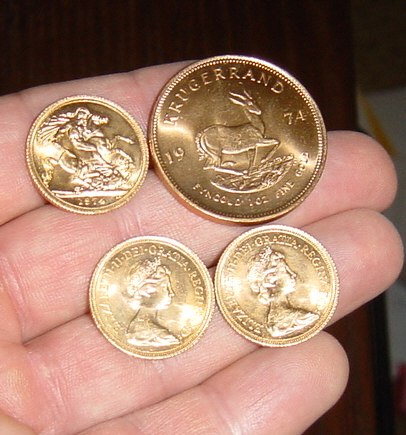



I am still working away on my NaNoWriMo project, but thought I'd take the time to share with the writer's community here some interesting things I've recently discovered about Gold.
Not mine, unfortunately. This image is from the Wikimedia Commons.
Released into the Public Domain by its creator, 'Although'.
Creation
All the gold on Earth was created in the explosion of a supernova. In fact it is only in these conditions of tremendous heat and pressure that lighter elements can be fused together to make atoms as massive as Gold. The Earth is a third generation star system formed out of the dust and gases released by such a supernova, which explains why Gold is found here.
Rarity
Gold is valuable for several reasons. Its natural lustre is eye catching, it's easily worked into useful items (it's thought to be the first metal used by prehistoric humans) and it is rare. It is believed that if all the Gold that has ever been refined were brought together in one place it would form a cube only 20 metres to a side with a weight of 154,400 metric tons (calculation based on a density of 19.3 grams per cubic centimetre).
Although this might seem a lot, it is tiny when compared to the amounts of baser metals that have been similarly refined. For example, the export of Iron ore to China from just one of Australia's mining companies per year is measured in the hundreds of millions of tons.
Speculative fiction writers should take away from this the idea that Gold should not be plentiful on their world without suitable justification. However, one of Gold's physical properties (see below) can make it appear that Gold is more plentiful than it really is.
Chemical Properties
Gold is one of the so-called Noble metals, which like the Noble gases I have mentioned in earlier articles, are characterised by not reacting with most commonly found substances in the environment. It does not rust or tarnish and for this reason it is very often used for electrical connections in places where corrosion can occur, even though copper is the better conductor.
From a writer's point of view, Gold with its high melting point of 1,064.18 degrees Centigrade, should survive most destructive events making it a very durable source of wealth which might lead to some interesting plot ideas.
Physical Properties
Gold is the most malleable and ductile metal known to man. A single gram can be beaten out into a square .6 metres on a side (without cracking or becoming brittle) and can be drawn into an extremely thin wire 3.2 kilometres long.
Although Gold does not react with other chemicals it does alloy with other metals. An alloy is basically a solid solution of two or more metals (no chemical bonds are formed) which gives the combined material properties different from either of the separate metals.
For example, the carat rating of Gold in jewellery indicates the amount of base metal added to the alloy (24 carat is solid Gold). This additional base metal is not just added to decrease the cost of the item. Added base metal is used to increase the hardness and decrease the ductility of the item to make it more durable. The coins in the image above are all 22 carat. The added Copper gives the coins makes the coins more hard wearing.
An additional effect is a change of colour in the metal. As can be seen in the image, Copper gives Gold alloys a reddish tinge, Silver makes it greenish-yellow, Palladium or Nickel is used to create White Gold, Iron imbues a blue colour to the alloy and Aluminium makes the alloy purple. Other changes in the alloy's properties makes some of these combinations unsuitable, which is why we don't see any purple Gold.
Gold's incredible malleability allows it to be beaten very thin (in fact, so thin that it can become translucent letting through light with a greenish hue). The resulting metallic foil is called Gold Leaf which is used for a number of different purposes ranging from gilding through to inclusion in food stuffs.
Gilding is the coating of items with Gold Leaf to give an object the appearance and incorruptible lustre of solid gold. Writers should appreciate that this is a commonly-used technique, which has been used for thousands of years in the creation of works of art. This means you can have your large gold statues and the like, but they are more likely to be gilded works of art than solid gold.
As usual there is more to this topic than I originally thought. Next article, hopefully in a week's time, will be about some of the more esoteric aspect of Gold.
Until then, its back to NaNoWriMo for me, where, as of this writing, I have a word count of 27,443.
References:
More on how Gold is created
http://ephemeris.sjaa.net/0706/f.html
The Properties of Gold
http://www.bbc.co.uk/dna/h2g2/A3327103
Gilding
http://en.wikipedia.org/wiki/Gilding
N.B. Please note that I although I use the Wikipedia (and WikiMedia Commons) a lot for references, this is for expediency and the familiarity of my readers. Anyone interested in further studies should make use of the references where available and understand that the Wikipedia is a co-operative project contributable to by anyone and must always be looked at in that light.
Phill Berrie, November, 2008.



